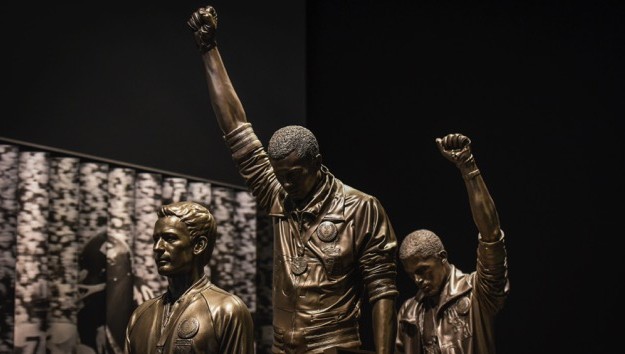
 Jahi Chikwendiu/The Washington Post via Getty Images(WASHINGTON) — The Smithsonian’s National Museum of African American History and Culture finally opens its doors Friday on the National Mall. It includes 12 inaugural exhibitions and close to 37,000 artifacts, but only 3,000 will be on display.
Jahi Chikwendiu/The Washington Post via Getty Images(WASHINGTON) — The Smithsonian’s National Museum of African American History and Culture finally opens its doors Friday on the National Mall. It includes 12 inaugural exhibitions and close to 37,000 artifacts, but only 3,000 will be on display.
Here are 10 must-see artifacts featured in the inaugural exhibit.
Rosa Parks’ Dress
Civil Rights activist Rosa Parks was also seamstress. This is the dress Parks was sewing before she was arrested for not giving up her seat on a segregated bus on Dec. 1, 1955.
Parks’ dress is part of the Black Fashion Museum Collection that was donated to NMAAHC.
Michael Jackson’s Fedora
This black fur felt fedora with a gold metal buckle was worn by Jackson during his Victory Tour. The fedora is featured in the Musical Crossroads exhibition on the fourth floor.
Musical Crossroads organizes the intersection of history and culture, grouping stories of musical genres and themes.
Segregation-era Southern Railway Car
A Southern Railway No. 1200 heavyweight passenger coach with segregated compartments.
The entire building is built around two signature items, one of which being a 77-ton, 44-seat segregation-era railway car which serviced Kentucky, Tennessee, Georgia and Florida between 1940 and 1960.
This artifact is part of the Segregation Gallery, that focuses on the years 1876 to 1968. The rail car was lifted off semi-trailers and lowered 60 feet into the bottom level of the museum during early stages of construction.
Angola Prison Guard Tower
The Angola Prison guard tower, one of two items the museum is built around, rests on the bottom level of the museum. Used by prison guards to watch prisoners at the Louisiana State Penitentiary in Angola, the prison tower stands nearly 21-feet-tall and 14-feet-wide.
Angola Prison, one of the largest maximum-security prisons in the nation, opened in 1901 and was built on former slave land.
The museum also has a 6-by-9-foot cell from another section of the prison that will be soon be installed in the museum.
Muhammad Ali Headgear
The Muhammad Ali headgear worn by the boxing legend at the 5th Street Gym in Miami is located in the ports exhibition as part of the Communities Gallery. During his time in Miami in the 1960s, Ali converted to Islam and changed his name.
The sports gallery looks at the contributions of African-American athletes.
Hope School Desk
School desks from the Hope School, a Rosenwald school in South Carolina, can be found on the third floor in the Community Gallery “Making a Way Out of No Way.” According to the museum, the Hope School was one of more than 5,000 rural schools supported by the Julius Rosenwald Fund. Artifacts donated from the Hope School include its original sign, 10 desks and a wood-burning stove.
The “Making A Way Out Of No Way” exhibition reflects stories of blacks’ perseverance, resourcefulness and resilience.
Nat Turner’s Bible
Nat Turner’s bible can be seen in the History Gallery “Slavery and Freedom.” Turner was a slave and minister who led a slave rebellion in Virginia in 1831. Descendants of Lavinia Francis, a slaveholder who survived the rebellion, donated the bible to the museum.
According to the museum, it is thought that Turner was holding this bible when he was captured two months after the rebellion.
President Obama Hand-painted Banner for Obama Presidential Campaign 2008
The museum brings visitors to the present day with a banner for Obama’s 2008 presidential campaign. Hand-painted in New Haven, Connecticut, this banner is one of the artifacts honoring our nation’s first black president and his legacy.
President Obama and First Lady Michelle Obama attended the museum’s groundbreaking ceremony in Washington, D.C., in February 2012. The president will deliver remarks during the museum’s opening ceremony where he will be joined by other distinguished guests.
1968 Olympic Warm-up Suit Worn by Tommie Smith
Upon entering the Sports Gallery, visitors are greeted by a statue from the 1968 Olympic Games in Mexico City where African-American athletes Tommie Smith and John Carlos raised their fists during the American National Anthem, making a political statement during the medal ceremony to bring attention to the inequality in the U.S.
The 1968 Olympic warm-up suit worn by Smith is here on display to honor the contributions of African-American athletes in sports.
Chuck Berry’s Cadillac
Chuck Berry’s Cadillac.
Chuck Berry’s red convertible Cadillac is part of his personal fleet and was driven during the filming of “Hail! Hail! Rock ’n’ Roll,” a 1987 documentary that chronicles two 1986 concerts celebrating his 60th birthday.
Copyright © 2016, ABC Radio. All rights reserved.










